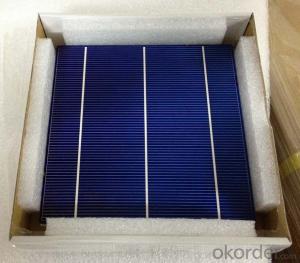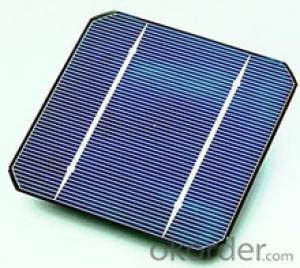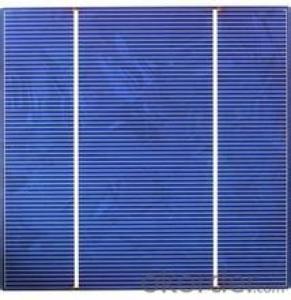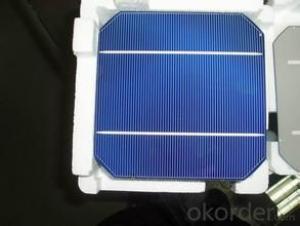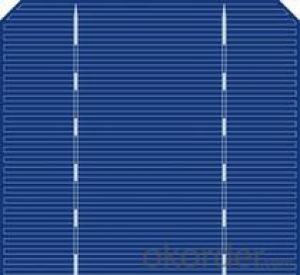Monocrytalline Silicon Solar Cells 156mm (14.00%----17.25%)
- Loading Port:
- Shanghai
- Payment Terms:
- TT OR LC
- Min Order Qty:
- 1000 watt
- Supply Capability:
- 100000000 watt/month
OKorder Service Pledge
OKorder Financial Service
You Might Also Like
Item specifice
1.Description of the Solar Cells
Monocrytalline Silicon Solar Cells 156mm (14.00%----17.25%)
We supply regular mono 125x125mm and poly 156x156mm solar cells.
Cells made in China mainland and Taiwan are both available.
Cell production capacity yearly reach 1GW.
Our cells pattern include continuous and uncontinuous busbar to meet different cells line.
2.Mechanical data and design of the Solar Cells
| Format | 156 mm × 156 mm ± 0.5 mm |
| Thickness- | 210 μm ± 40 μm |
| Front (-) | 1.5 mm bus bars (silver),blue anti-reflection coating (silicon nitride) |
| Back (+) | 2.5 mm wide soldering pads (silver) back surface field (aluminium) |
3. Temperature Coefficient of the Solar Cells
| Voc. Temp .coef.%/K | -0.351%/K |
| Isc . Temp .coef.%/K | +0.035%/K |
| Pm. Temp. coef.%/K | -0.47%/K |
4.Electrical Characteristic of the Solar Cells
Efficiency (%) | Pmpp (W) | Umpp (V) | Impp (A) | Uoc (V) | Isc (A) | FF (%) | ||
17.25 | 4.197 | 0.524 | 7.992 | 0.62 | 8.458 | 80.03% | ||
17 | 4.137 | 0.524 | 7.876 | 0.619 | 8.353 | 80.01% | ||
16.75 | 4.076 | 0.522 | 7.81 | 0.617 | 8.286 | 79.73% | ||
16.5 | 4.015 | 0.518 | 7.746 | 0.613 | 8.215 | 79.73% | ||
16.25 | 3.955 | 0.515 | 7.683 | 0.61 | 8.144 | 79.61% | ||
16 | 3.894 | 0.512 | 7.613 | 0.608 | 8.075 | 79.31% | ||
15.75 | 3.833 | 0.51 | 7.534 | 0.605 | 8.058 | 78.62% | ||
15.5 | 3.772 | 0.508 | 7.453 | 0.604 | 8.02 | 77.87% | ||
15.25 | 3.711 | 0.505 | 7.35 | 0.604 | 7.997 | 76.83% | ||
15 | 3.65 | 0.503 | 7.271 | 0.604 | 7.989 | 75.64% | ||
14.5 | 3.529 | 0.499 | 7.067 | 0.604 | 7.988 | 73.14% | ||
14 | 3.407 | 0.499 | 6.833 | 0.604 | 7.833 | 72.01% | ||
5.Intensity Dependence of the Solar Cells
Intensity [W/m2] | sc× [mA] | Voc× [mV] |
1000 | 1.00 | 1.000 |
900 | 0.90 | 0.989 |
500 | 0.50 | 0.963 |
300 | 0.30 | 0.939 |
200 | 0.20 | 0.920 |
6.Applications of the Solar Cells
electric power generation
7.IMages of the Solar Cells
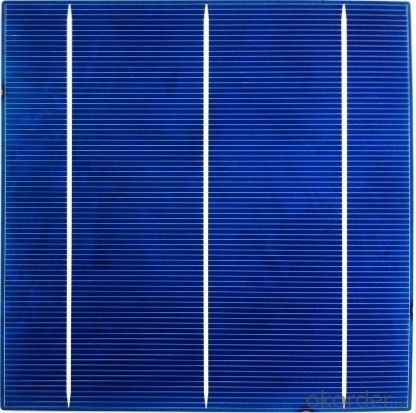

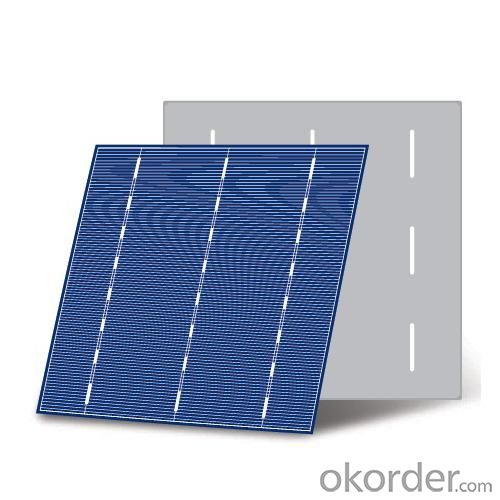
FAQ
- Q:Can solar cells be used for powering manufacturing facilities?
- Yes, solar cells can be used to power manufacturing facilities. Solar energy can be harnessed through the use of photovoltaic panels, which convert sunlight into electricity. This renewable source of energy can be utilized to meet the power demands of manufacturing facilities, reducing their reliance on traditional grid electricity and helping to reduce carbon emissions.
- Q:Can solar cells be used to power remote monitoring systems?
- Yes, solar cells can be used to power remote monitoring systems. Solar cells convert sunlight into electricity, providing a reliable and sustainable source of power for monitoring devices located in remote or off-grid areas where traditional power sources are not available or feasible. This makes solar cells an ideal solution for powering remote monitoring systems.
- Q:Are solar cells weather-resistant?
- Yes, solar cells are weather-resistant. They are designed to withstand various weather conditions such as rain, snow, heat, and cold. However, extreme weather events like hurricanes or hailstorms can potentially damage solar cells.
- Q:What is the expected degradation rate of a solar cell?
- The expected degradation rate of a solar cell can vary depending on various factors such as the quality of materials used, manufacturing processes, environmental conditions, and maintenance practices. However, on average, a well-designed and properly maintained solar cell can experience an annual degradation rate of around 0.5% to 1%. This means that over time, the solar cell's efficiency may decrease by 0.5% to 1% per year.
- Q:Do solar cells work in cloudy weather?
- Yes, solar cells can still generate electricity in cloudy weather, although their efficiency is reduced compared to when they are exposed to direct sunlight.
- Q:Can solar cells be used for powering remote sensing devices?
- Yes, solar cells can be used to power remote sensing devices. Solar cells convert sunlight into electricity, which can then be used to power various electronic devices, including remote sensing devices. This renewable energy source is particularly advantageous for remote sensing applications as it eliminates the need for traditional power sources and allows for greater flexibility and portability in remote locations.
- Q:How do solar cells perform in dusty environments?
- Solar cells performance in dusty environments can be significantly affected. The accumulation of dust on the surface of the cells reduces the amount of sunlight reaching the cells, leading to a decrease in their efficiency. Regular cleaning and maintenance are required to ensure optimal performance in such conditions.
- Q:Can solar cells be used for powering data centers?
- Yes, solar cells can be used to power data centers. Solar energy can be harnessed through photovoltaic panels to generate electricity which can then be used to power the infrastructure of data centers. This renewable energy source can help reduce the carbon footprint and dependency on fossil fuels, making data centers more sustainable and environmentally friendly.
- Q:How do solar cells perform in areas with high levels of dust storms?
- Solar cells can experience reduced performance in areas with high levels of dust storms. The accumulation of dust on the surface of solar panels can block sunlight and reduce the amount of energy they can generate. Regular cleaning and maintenance are necessary to ensure optimal performance in such regions.
- Q:How do solar cells perform in coastal areas?
- Solar cells perform well in coastal areas due to the abundance of sunlight and the absence of obstructions that could potentially shade the panels. Additionally, the coastal breeze helps to keep the solar panels cool, preventing overheating and improving their overall efficiency.
1. Manufacturer Overview |
|
|---|---|
| Location | |
| Year Established | |
| Annual Output Value | |
| Main Markets | |
| Company Certifications | |
2. Manufacturer Certificates |
|
|---|---|
| a) Certification Name | |
| Range | |
| Reference | |
| Validity Period | |
3. Manufacturer Capability |
|
|---|---|
| a)Trade Capacity | |
| Nearest Port | |
| Export Percentage | |
| No.of Employees in Trade Department | |
| Language Spoken: | |
| b)Factory Information | |
| Factory Size: | |
| No. of Production Lines | |
| Contract Manufacturing | |
| Product Price Range | |
Send your message to us
Monocrytalline Silicon Solar Cells 156mm (14.00%----17.25%)
- Loading Port:
- Shanghai
- Payment Terms:
- TT OR LC
- Min Order Qty:
- 1000 watt
- Supply Capability:
- 100000000 watt/month
OKorder Service Pledge
OKorder Financial Service
Similar products
New products
Hot products
Hot Searches
Related keywords

